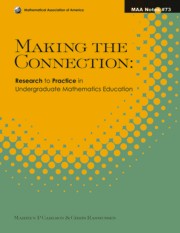Book contents
- Frontmatter
- Preface
- Contents
- Part 1 Student Thinking
- Part 2 Cross-Cutting Themes
- 2a Interacting with Students
- 13 Meeting New Teaching Challenges: Teaching Strategies that Mediate Between All Lecture and All Student Discovery
- 14 Examining Interaction Patterns in College-Level Mathematics Classes: A Case Study
- 15 Mathematics as a Constructive Activity: Exploiting Dimensions of Possible Variation
- 16 Supporting High Achievement in Introductory Mathematics Courses: What We Have Learned from 30 Years of the Emerging Scholars Program
- 2b Using Definitions, Examples and Technology
- 17 The Role of Mathematical Definitions in Mathematics and in Undergraduate Mathematics Courses
- 18 Computer-Based Technologies and Plausible Reasoning
- 19 Worked Examples and Concept Example Usage in Understanding Mathematical Concepts and Proofs
- 2c Knowledge, Assumptions, and Problem Solving Behaviors for Teaching
- 20 From Concept Images to Pedagogic Structure for a Mathematical Topic
- 21 Promoting Effective Mathematical Practices in Students: Insights from Problem Solving Research
- 22 When Students Don't Apply the Knowledge You Think They Have, Rethink Your Assumptions about Transfer
- 23 How Do Mathematicians Learn To Teach? Implications from Research on Teachers and Teaching for Graduate Student Professional Development
- About the Editors
15 - Mathematics as a Constructive Activity: Exploiting Dimensions of Possible Variation
from Part 2 - Cross-Cutting Themes
- Frontmatter
- Preface
- Contents
- Part 1 Student Thinking
- Part 2 Cross-Cutting Themes
- 2a Interacting with Students
- 13 Meeting New Teaching Challenges: Teaching Strategies that Mediate Between All Lecture and All Student Discovery
- 14 Examining Interaction Patterns in College-Level Mathematics Classes: A Case Study
- 15 Mathematics as a Constructive Activity: Exploiting Dimensions of Possible Variation
- 16 Supporting High Achievement in Introductory Mathematics Courses: What We Have Learned from 30 Years of the Emerging Scholars Program
- 2b Using Definitions, Examples and Technology
- 17 The Role of Mathematical Definitions in Mathematics and in Undergraduate Mathematics Courses
- 18 Computer-Based Technologies and Plausible Reasoning
- 19 Worked Examples and Concept Example Usage in Understanding Mathematical Concepts and Proofs
- 2c Knowledge, Assumptions, and Problem Solving Behaviors for Teaching
- 20 From Concept Images to Pedagogic Structure for a Mathematical Topic
- 21 Promoting Effective Mathematical Practices in Students: Insights from Problem Solving Research
- 22 When Students Don't Apply the Knowledge You Think They Have, Rethink Your Assumptions about Transfer
- 23 How Do Mathematicians Learn To Teach? Implications from Research on Teachers and Teaching for Graduate Student Professional Development
- About the Editors
Summary
Introduction
Mathematics is often seen by learners as a collection of concepts and techniques for solving problems assigned as homework. Learners, especially in cognate disciplines such as engineering, computer science, geography, management, economics, and the social sciences, see mathematics as a toolbox on which they are forced to draw at times in order to pursue their own discipline. They want familiarity and fluency with necessary techniques as tools to get the answers they seek. For them, learning mathematics is seen as a matter of training behaviour sufficiently to be able to perform fluently and competently on tests, and to use mathematics as a tool when necessary.
Unfortunately this pragmatic and tool-based perspective may cut people off from the creative and constructive aspects of mathematics, making it more difficult for them to know when to use mathematics, or to be flexible in their use of it. On its own, this perspective can reinforce a cycle of de-motivation and disinclination. The result is a descending spiral of inattention, minimal investment of energy and time, and absence of appreciation and understanding, leaving learners disempowered from pursuing their discipline through the use of mathematics.
By contrast, mathematicians see mathematics as a domain of creativity and discovery in its articulation, proof, and application. Full appreciation of a mathematical topic includes the exposure of underlying structure as well as the distillation and abstraction of techniques that solve classes of problems, together with component concepts.
- Type
- Chapter
- Information
- Making the ConnectionResearch and Teaching in Undergraduate Mathematics Education, pp. 191 - 204Publisher: Mathematical Association of AmericaPrint publication year: 2008
- 15
- Cited by



